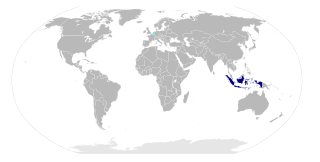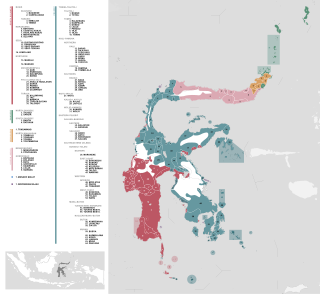Related Research Articles

Indonesian is the official and national language of Indonesia. It is a standardized variety of Malay, an Austronesian language that has been used as a lingua franca in the multilingual Indonesian archipelago for centuries. With over 280 million inhabitants, Indonesia ranks as the fourth most populous nation globally. According to the 2020 census, over 97% of Indonesians are fluent in Indonesian, making it the largest language by number of speakers in Southeast Asia and one of the most widely spoken languages in the world. Indonesian vocabulary has been influenced by various regional languages such as Javanese, Sundanese, Minangkabau, Balinese, Banjarese, and Buginese, as well as by foreign languages such as Arabic, Dutch, Portuguese, and English. Many borrowed words have been adapted to fit the phonetic and grammatical rules of Indonesian, enriching the language and reflecting Indonesia's diverse linguistic heritage.

Makassarese, sometimes called Makasar, Makassar, or Macassar, is a language of the Makassarese people, spoken in South Sulawesi province of Indonesia. It is a member of the South Sulawesi group of the Austronesian language family, and thus closely related to, among others, Buginese, also known as Bugis. The areas where Makassarese is spoken include the Gowa, Sinjai, Maros, Takalar, Jeneponto, Bantaeng, Pangkajene and Islands, Bulukumba, and Selayar Islands Regencies, and Makassar. Within the Austronesian language family, Makassarese is part of the South Sulawesi language group, although its vocabulary is considered divergent compared to its closest relatives. In 2000, Makassarese had approximately 2.1 million native speakers.
In addition to its classical and modern literary form, Malay had various regional dialects established after the rise of the Srivijaya empire in Sumatra, Indonesia. Also, Malay spread through interethnic contact and trade across the south East Asia Archipelago as far as the Philippines. That contact resulted in a lingua franca that was called Bazaar Malay or low Malay and in Malay Melayu Pasar. It is generally believed that Bazaar Malay was a pidgin, influenced by contact among Malay, Hokkien, Portuguese, and Dutch traders.
Manado Malay, or simply the Manado language, is a creole language spoken in Manado, the capital of North Sulawesi province in Indonesia, and the surrounding area. The local name of the language is bahasa Manado, and the name Minahasa Malay is also used, after the main ethnic group speaking the language. Since Manado Malay is used primarily for spoken communication, there is no standard orthography.

The Banjar or Banjarese is an Austronesian language predominantly spoken by the Banjarese—an indigenous ethnic group native to Banjar regions— in the southeastern Kalimantan of Indonesia. The Banjarese language is the de facto lingua franca for various indigenous community especially in South Kalimantan, as well as Central Kalimantan and East Kalimantan in general.
Wolio is an Austronesian language spoken in and around Baubau on Buton Island, Southeast Sulawesi, Indonesia. It belongs to the Wotu–Wolio branch of the Celebic subgroup. Also known as Buton, it is a trade language and the former court language of the Sultan at Baubau. Today it is an official regional language; street signs are written in the Buri Wolio alphabet, based on the Arabic script.
The Gorontalo–Mongondow languages are a group of Austronesian languages spoken in northern Sulawesi, Indonesia.
The Kaili–Pamona languages are a branch of the Celebic subgroup in the Austronesian language family spoken in western Central Sulawesi province, Indonesia.

On the Indonesian island of Sulawesi, 114 native languages are spoken, all of which belong to the Malayo-Polynesian subgroup of the Austronesian language family. With a total number of 17,200,000 inhabitants, Sulawesi displays a high linguistic diversity when compared with the most densely populated Indonesian island Java, which hosts 4–8 languages spoken by 145,100,000 inhabitants.

Cia-Cia, also known as Buton or Butonese, is an Austronesian language spoken principally around the city of Baubau on the southern tip of Buton island, off the southeast coast of Sulawesi, in Indonesia. It is written using the Latin and Hangul scripts.
Kei is an Austronesian language spoken in a small region of the Moluccas, a province of Indonesia.
Kaili is an Austronesian dialect cluster of the Celebic branch, and is one of the principal languages of Central Sulawesi. The heartland of the Kaili area is the broad Palu River valley which stretches southward from Central Sulawesi's capital city, Palu. Kaili is also spoken in the mountains which rise on both sides of this valley, and along the coasts of the Makassar Strait and the Gulf of Tomini.

Tontemboan is an Austronesian language, of northern Sulawesi, Indonesia. It is a Minahasan language, a sub-group of the Philippine languages.
Muna is an Austronesian language spoken principally on the island of Muna as well as North-west Buton Island, off the southeast coast of Sulawesi in Indonesia. The language is well-documented, especially by linguist René van den Berg. In 2010, the language had around 270,000 speakers.
Napu is an Austronesian language spoken in the North Lore district of Central Sulawesi, Indonesia. Together with Bada and Behoa, it belongs to the Badaic subgroup.
Tondano is an Austronesian language spoken in the Tondano area of northeast Sulawesi, Indonesia. It is most similar to Tombulu and to Tonsea.
Tonsawang, also known as Tombatu, is an Austronesian language of the northern tip of Sulawesi, Indonesia. It belongs to the Minahasan branch of the Philippine languages.
Suwawa is a Philippine language spoken in North Sulawesi (Celebes), Indonesia. It is also known as Bonda, Bone, Bunda, Bune, Suvava, and Toewawa. The language mostly spoken in Suwawa District, Regency of Bone Bolango.
Lindu or Tado is an Austronesian language of Central Sulawesi, Indonesia spoken by the Lindu people. It is closely related to Moma.
Wakasihu, or Larike-Wakasihu after the two still-vigorous dialects, is an Austronesian language of Ambon Island in the Maluku Islands.
References
- 1 2 Moma at Ethnologue (18th ed., 2015) (subscription required)
- 1 2 3 Adriani, N.; Esser, S. J. (1939). Koelawische Taalstudie[Kulawi Language Study]. Bibliotheca Celebica, I, II, III (in Dutch). Bandoeng: A. C. Nix. (3 vols).
- ↑ Sneddon, J. N. (1993). "The Drift Towards Final Open Syllables in Sulawesi Languages". Oceanic Linguistics. 32 (1): 1–44. doi:10.2307/3623095. JSTOR 3623095.